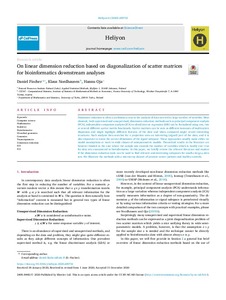On linear dimension reduction based on diagonalization of scatter matrices for bioinformatics downstream analyses
Fischer D.; Nordhausen K.; Oja H.
https://urn.fi/URN:NBN:fi-fe2021042821856
Tiivistelmä
Dimension reduction is often a preliminary step in the analysis of data sets with a large number of variables. Most classical, both supervised and unsupervised, dimension reduction methods such as principal component analysis (PCA), independent component analysis (ICA) or sliced inverse regression (SIR) can be formulated using one, two or several different scatter matrix functionals. Scatter matrices can be seen as different measures of multivariate dispersion and might highlight different features of the data and when compared might reveal interesting structures. Such analysis then searches for a projection onto an interesting (signal) part of the data, and it is also important to know the correct dimension of the signal subspace. These approaches usually make either no model assumptions or work in wide classes of semiparametric models. Theoretical results in the literature are however limited to the case where the sample size exceeds the number of variables which is hardly ever true for data sets encountered in bioinformatics. In this paper, we briefly review the relevant literature and explore if the dimension reduction tools can be used to find relevant and interesting subspaces for small-n-large-p data sets. We illustrate the methods with a microarray dataset of prostate cancer patients and healthy controls.
Kokoelmat
- Rinnakkaistallenteet [27094]
